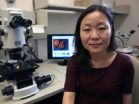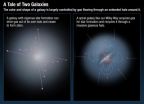(Press-News.org) Researchers the world over are seeking reliable ways to predict earthquakes, focusing on identifying seismic precursors that, if detected early enough, could serve as early warnings.
New research, published this week in the journal Applied Physics Letters, suggests that ozone gas emitted from fracturing rocks could serve as an indicator of impending earthquakes. Ozone is a natural gas, a byproduct of electrical discharges into the air from several sources, such as from lightning, or, according to the new research, from rocks breaking under pressure.
Scientists in the lab of Raúl A. Baragiola, a professor of engineering physics in the University of Virginia School of Engineering and Applied Science set up experiments to measure ozone produced by crushing or drilling into different igneous and metamorphic rocks, including granite, basalt, gneiss, rhyolite and quartz. Different rocks produced different amounts of ozone, with rhyolite producing the strongest ozone emission.
Some time prior to an earthquake, pressures begin to build in underground faults. These pressures fracture rocks, and presumably, would produce detectable ozone.
To distinguish whether the ozone was coming from the rocks or from reactions in the atmosphere, the researchers conducted experiments in pure oxygen, nitrogen, helium and carbon dioxide. They found that ozone was produced by fracturing rocks only in conditions containing oxygen atoms, such as air, carbon dioxide and pure oxygen molecules, indicating that it came from reactions in the gas. This suggests that rock fractures may be detectable by measuring ozone.
Baragiola began the study by wondering if animals, which seem – at least anecdotally – to be capable of anticipating earthquakes, may be sensitive to changing levels of ozone, and therefore able to react in advance to an earthquake. It occurred to him that if fracturing rocks create ozone, then ozone detectors might be used as warning devices in the same way that animal behavioral changes might be indicators of seismic activity.
He said the research has several implications.
"If future research shows a positive correlation between ground-level ozone near geological faults and earthquakes, an array of interconnected ozone detectors could monitor anomalous patterns when rock fracture induces the release of ozone from underground and surface cracks," he said.
"Such an array, located away from areas with high levels of ground ozone, could be useful for giving early warning to earthquakes."
He added that detection of an increase of ground ozone might also be useful in anticipating disasters in tunnel excavation, landslides and underground mines.
###
Baragiola's co-authors are U.Va. research scientist Catherine Dukes and visiting student Dawn Hedges.
Study: Ozone from rock fracture could serve as earthquake early warning
2011-11-21
ELSE PRESS RELEASES FROM THIS DATE:
Study explains how heart attack can lead to heart rupture
2011-11-21
For people who initially survive a heart attack, a significant cause of death in the next few days is cardiac rupture -- literally, bursting of the heart wall.
A new study by University of Iowa researchers pinpoints a single protein as the key player in the biochemical cascade that leads to cardiac rupture. The findings, published Nov. 13 as an Advance Online Publication (AOP) of the journal Nature Medicine, suggest that blocking the action of this protein, known as CaM kinase, may help prevent cardiac rupture and reduce the risk of death.
After a heart attack, the ...
Multidisciplinary team of researchers develop world’s lightest material
2011-11-21
Irvine, Calif., Nov. 17, 2011 – A team of researchers from UC Irvine, HRL Laboratories and the California Institute of Technology have developed the world's lightest material – with a density of 0.9 mg/cc – about 100 times lighter than Styrofoam. Their findings appear in the Nov. 18 issue of Science.
The new material redefines the limits of lightweight materials because of its unique "micro-lattice" cellular architecture. The researchers were able to make a material that consists of 99.99 percent air by designing the 0.01 percent solid at the nanometer, micron and millimeter ...
NIH-funded scientists identify potential malaria drug candidates
2011-11-21
Caused by four related parasites in the genus Plasmodium, malaria is transmitted to humans via the bite of an infected mosquito. Once the bite occurs, the parasites travel to the liver, where they usually multiply rapidly for about a week without causing symptoms. Symptoms begin when the parasites spread from the liver to the rest of the body through the bloodstream. However, the parasites can lay dormant in the liver for periods ranging from several months to years before an infected person demonstrates symptoms.
Most of the malaria drugs currently in development target ...
Soybean adoption came early by many cultures, archaeologists say
2011-11-21
EUGENE, Ore. -- Human domestication of soybeans is thought to have first occurred in central China some 3,000 years ago, but archaeologists now suggest that cultures in even earlier times and in other locations adopted the legume (Glycine max).
Comparisons of 949 charred soybean samples from 22 sites in northern China, Japan and South Korea -- found in ancient households including hearths, flooring and dumping pits -- with 180 modern charred and unburned samples were detailed in the Nov. 4 edition of the online journal PLoS ONE, a publication of the Public Library ...
What bacteria don't know can hurt them
2011-11-21
Many infections, even those caused by antibiotic-sensitive bacteria, resist treatment. This paradox has vexed physicians for decades, and makes some infections impossible to cure.
A key cause of this resistance is that bacteria become starved for nutrients during infection. Starved bacteria resist killing by nearly every type of antibiotic, even ones they have never been exposed to before.
What produces starvation-induced antibiotic resistance, and how can it be overcome? In a paper appearing this week in Science, researchers report some surprising answers.
"Bacteria ...
UofL researcher determines how Legionnaires' bacteria proliferate, cause disease
2011-11-21
LOUISVILLE, Ky. – A University of Louisville scientist has determined for the first time how the bacterium that causes Legionnaires' disease manipulates our cells to generate the amino acids it needs to grow and cause infection and inflammation in the lungs. The results are published online today (Nov. 17) in "Science."
Yousef Abu Kwaik, Ph.D., the Bumgardner Endowed Professor in Molecular Pathogenesis of Microbial Infections at UofL, and his team believe their work could help lead to development of new antibiotics and vaccines.
"It is possible that the process we have ...
NASA's Hubble confirms that galaxies are the ultimate recyclers
2011-11-21
New observations by NASA's Hubble Space Telescope are expanding astronomers' understanding of the ways in which galaxies continuously recycle immense volumes of hydrogen gas and heavy elements. This process allows galaxies to build successive generations of stars stretching over billions of years.
This ongoing recycling keeps some galaxies from emptying their "fuel tanks" and stretches their star-forming epoch to over 10 billion years.
This conclusion is based on a series of Hubble Space Telescope observations that flexed the special capabilities of its Cosmic Origins ...
Assembly stand completed for NASA's Webb Telescope flight optics
2011-11-21
GREENBELT, Md. -- The cleanroom at NASA's Goddard Space Flight Center in Greenbelt, Md. has received a giant structural steel frame that will be used to assemble the mirrors and instruments of the James Webb Space Telescope.
"This milestone is important as it marks the transition to the integration and testing phase for the Webb telescope's optical telescope element," said Lee Feinberg, Optical Telescope Element Manager for the Webb telescope at Goddard.
The Webb telescope is the world's next-generation space observatory and scientific successor to the Hubble Space ...
UGA researchers develop 'super' yeast that turns pine into ethanol
2011-11-21
Athens, Ga. – Researchers at the University of Georgia have developed a "super strain" of yeast that can efficiently ferment ethanol from pretreated pine -- one of the most common species of trees in Georgia and the U.S. Their research could help biofuels replace gasoline as a transportation fuel.
"Companies are interested in producing ethanol from woody biomass such as pine, but it is a notoriously difficult material for fermentations," said Joy Doran-Peterson, associate professor of microbiology in the Franklin College of Arts and Sciences.
"The big plus for softwoods, ...
Combo hormone therapy has increased breast cancer risk over estrogen alone
2011-11-21
The debate about using menopausal hormone therapies to relieve symptoms in post-menopausal women has been ongoing. Is the combination therapy of estrogen and progestin better or worse than just giving women estrogen alone? In women who still have a uterus (those who have not had a hysterectomy), progestin counteracts the increased risk of uterus cancer when estrogen is given alone, but at the expense of an increase in breast cancer risk compared to estrogen alone.
Now a study by researchers at UCLA's Jonsson Comprehensive Cancer Center has found that women taking the ...



